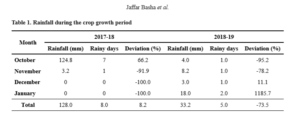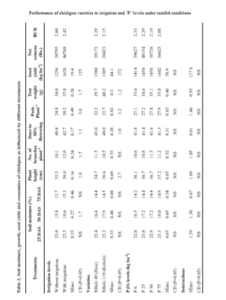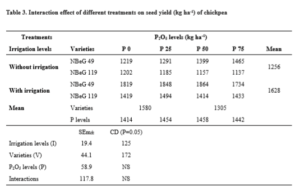PERFORMANCE OF CHICKPEA (Cicer arietinum L.) VARIETIES TO IRRIGATION AND PHOSPHOROUS LEVELS IN VERTISOLS UNDER RAINFED CONDITION
0 Views
S. JAFFAR BASHA*, V. JAYALAKSHMI, S. KHAYUM AHAMMED, N. KAMAKSHI AND A. TRIVIKRAM REDDY
Regional Agricultural Research Station, ANGRAU, Nandyal-518502, Kurnool District, Andhra Pradesh, India
ABSTRACT
Field investigation was undertaken for two consecutive years (2017-18 and 2018 -19) at Regional Agricultural Research Station, Nandyal, Andhra Pradesh during rabi on vertisols to estimate growth parameters, yield attributes and yield of chickpea varieties relative to irrigation and phosphorus levels under rainfed condition. The experiment was carried out in split split plot design with two irrigation levels (without irrigation and with irrigation) as main plots, two varieties (Desi -NBeG 49 and Kabuli – NBeG 119) as sub plots and four phosphorus levels (0, 25, 50, 75 kg ha-1) as sub sub plots with three replications. Significantly higher number of pods (30.2 plant-1), seed yield (1628 kg ha-1) and net returns (Rs 46,768 ha-1) were recorded with application of irrigation when compared to without irrigation (24.8 plant-1, 1256 kg ha-1 and Rs 30,795 ha-1). NBeG 49 recorded higher number of pods (32.2 plant-1) and seed yield (1580 kg ha-1) when compared to NBeG 119 (22.7 plant-1 and 1305 kg ha-1). Phosphorus levels did not exert any significant influence on growth parameters, yield attributes and seed yield of chickpea.
KEYWORDS:
Chickpea, irrigation, varieties, phosphorus, seed yield
INTRODUCTION
Chickpea (Cicer arietinum L.) is an important legume crop cultivated and consumed across the world. Among the different countries in the world, India is the largest producer and consumer of chickpea. It is grown in an area of about 9.85 Mha with a production of 10.32 Mt and productivity of 1048 kg ha-1 (http: //www. agricoop.nic.in). In Andhra Pradesh it is grown in an area of 0.58 Mha with a production of 0.72 Mt and productivity of 1241 kg ha-1. Chickpea is rabi crop generally cultivated under conditions of residual soil moisture and often subjected to deficit moisture after sowing. In chickpea, branching (pre flowering) and pod development stages are moisture sensitive stages. Water stress adversely affects many aspects of plant growth, which ultimately reduce dry matter production and seed yield. Reduction in seed yield depends on stage of crop growth, intensity and duration of stress. Phosphorus is important plant nutrient involved in wide range of plant processes from permitting cell division to the development of a good root system. Legumes generally have a higher phosphorus requirement as lot of energy is consumed during the process of symbiotic nitrogen fixation. Farmers are applying higher doses of complex fertilizers to chickpea. Vertisols have medium to high range of phosphorus. Under the above circumstances, the present work was undertaken to study the effect of irrigation levels and different phosphorus doses on performance of chickpea varieties under rainfed conditions.
MATERIAL AND METHODS
The present experiment was carried out during rabi for two consecutive years (2017-18 and 2018-19) at Regional Agricultural Research Station, Nandyal (ANGRAU), Andhra Pradesh. The investigation was carried out in split-split plot design with two irrigation levels (without irrigation and with irrigation) as main plots, two varieties (NBeG 49 and NBeG 119) as sub plots and four phosphorus levels (0, 25, 50, 75 kg ha-1) as sub sub plots sown at 30 cm × 10 cm spacing with three replications. The soil of the experimental soil is moderately alkaline (pH-8.3), non saline (EC-0.15 dSm1), low in available nitrogen (113 kg ha-1), medium in available phosphorus (48.5 kg ha-1) and high in available potassium (366 kg ha-1). All the recommended package of practices was adopted to raise chickpea. One light irrigation (30 mm) was given at branching stage (pre flowering). Soil samples were collected and soil moisture at different intervals was calculated by gravimetric method. Observations were recorded from five randomly selected plants from each treatment in each replication to estimate the growth and yield parameters. The data recorded on soil moisture, plant height (cm), number of branches, days to 50% flowering, number of pods per plant, test weight (g), seed yield (kg ha-1) and harvest index (%) were subjected to statistical analysis by adopting Fisher’s method of analysis of variance at 5% level of significance as outlined by Gomez & Gomez (1984).

RESULTS AND DISCUSSION
Rainfall during the crop growth period
During the experimentation period chickpea was sown during the second fortnight of October and harvested in the second fortnight of January. During 201718, 128.0 mm rainfall (8.2% higher than normal) in 8 rainy days was received during crop growth period whereas during 2018-19, 33.2 mm rainfall (73.5% lower than normal) in 5 rainy days was received during crop growth period (Table 1). During 2017-18, except 3.2 mm rain in November there was no rainfall further affects the growth and yield of chickpea. During 2018-19, chickpea was sown during October with pre-sowing irrigation due to non receipt of sufficient rainfall. There was deficit rainfall during crop growth period which affected the growth and yield of the chickpea.
Available soil moisture
The analysis of variance was significant for quantitative traits due to irrigation levels and varieties. The data in table 2 showed that irrigation levels did not influence the available soil moisture at 25 and 75 days after sowing (DAS) but significantly higher soil moisture (18.6%) was recorded at 50 DAS with one irrigation at pre flowering stage/branching stage when compared to without irrigation (15.8%). Different varieties and phosphorus doses did not influenced the available soil moisture at different intervals.
Growth parameters and seed yield
Significantly higher plant height (38.0 cm), days to 50% flowering (42.7 days), pods plant-1 (30.2), test weight (35.8 gm), seed yield (1628 kg ha-1), net returns (Rs 46,768 ha-1) and BCR (2.42) was recorded with irrigation when compared to without irrigation (35.3 cm, 40.4 days, 24.8, 34.0 gm, 1256 kg ha-1, Rs 30,795 ha-1 and BCR of 2.00 respectively). Irrigation influenced the crop growth and increased the seed yield of chickpea by 29.6 per cent. The result is in confirmation with Palled et al. (1995), where they reported that the number of branches plant-1 increased due to irrigation in blackgram. Significantly higher number of pods plant-1 and 100 seed weight with irrigation at pod development stage over irrigation at flowering and no irrigation might be due to better translocation of absorbed nutrients coupled with supply of soil moisture which coincided with peak pod and seed development stages (Fallah et al., 2005). The results indicated that number of branches plant-1 increased with increasing soil moisture content. Reduced number of branches plant-1 might be due to inhibition of cell division and cell enlargement under water stress (Mariam et al., 2014). Significantly lower plant height (34.7 cm), higher number of days to 50% flowering (43.0 days), pods plant1 (32.2), lower test weight (29.7 gm), higher seed yield (1580 kg ha-1), net returns (Rs 39,173 ha-1) and BCR of 2.29 was observed with Desi variety NBeG 49. Significantly higher plant height (38.6 cm), lower days


to 50% flowering (40.0 days), pods plant-1 (22.7), higher test weight (40.2 gm), lower seed yield (1305 kg ha-1), net returns (Rs 38,423 ha-1) and BCR of 2.15 was observed with Kabuli variety NBeG 119. A wide range of variation was observed for all traits under study suggesting variability among the genotypes for these traits. Results of the present investigation are in conformity with Ramanappa et al. (2013). The estimates of variability revealed that genetic variability was significant among the genotypes under study. The present findings were in accordance with Parameswarappa et al.(2012) for plant height and days to 50% flowering. Similar result was reported by Alkadev et al. (2017) for 100 seed weight. The variation for different qualitative and quantative traits in chickpea could help breeders to release better and superior lines and varieties (Malik et al. 2010; Rozina and Hamayoon, 2011). Different phosphorus levels did not influence growth, yield parameters and seed yield. This could be due to productive soil status for supply of phosphorus. Similar results were also reported by Nawange et al. (2011), Yadav et al. (2016) and Basha et al., (2018). The genotype NBeG 49 cultivated with application of 50 kg P ha-1 and with one irrigation at pre flowering/branching recorded higher seed yield (1864 kg ha-1) compared to NBeG 119 cultivated without application of phosphorus and irrigation (1202 kg ha-1) (Table 3).
It can be concluded that, most of the morphological and yield attributes such as plant height, pods plant-1, test weight, seed yield were enhanced significantly due to application of irrigation. Cultivation of desi variety NBeG 49 with application of 50 kg P2O5 ha-1 with one light irrigation (30 mm) at branching stage/pre flowering enhanced the productivity of chickpea under moisture deficit condition in vertisols.
ACKNOWLEDGEMENT
The authors are grateful to All India Co-ordinated Research Project on Chickpea and Regional Agricultural Research Station, Nandyal (ANGRAU), Andhra Pradesh for providing the facilities for smooth conduct of the experiment.
Performance of chickpea varieties to irrigation and ‘P’ levels under rainfed conditions
LITERATURE CITED
Alkadev, Preeti, V and Bherulal, K. 2017. Genetic variability studies in desi chickpea (Cicer arietinum L) genotypes. International Journal of Current Microbiology and Applied Sciences. 6(4): 20-25.
Basha, S.J., Jayalakshmi, V., Reddy, A.T., Kamakshi, N and Ahammed, S.K. 2018. Response of chickpea (Cicer arietinum L.) varieties to irrigation and phosphorus levels in vertisols. International Journal of Pure and Applied Biosciences. 6(5): 1001-1004.
Directorate of Economics and Statistics, Ministry of Agriculture, Govt. of India. New Delhi 2019. Available on http://www. agricoop.nic.in.
Fallah, S., Ehsanzadeh, P and Daneshvar, M. 2005. Seed yield and yield components in three chickpea genotypes under dryland conditions with and without supplementary irrigation at different plant densities in Khorram-Abad, Lorestan. Iranian Journal of Agricultural Sciences. 36(3): 719-731.
Gomez, K.A and Gomez, A.A. 1984. Statistical procedures for agricultural research. 2nd Ed. John Wiley and Sons, New York.
Malik, S.R., Bakhsh, A., Asif, M.A., Iqbal, U and Iqbal, S.M. 2010. Assessment of genetic variability and interrelationship among some agronomic traits in chickpea. International Journal of Agricultural Biology. 12:81-85.
Mariam, B., Bala, P and Hafizur, R.H. 2014. Irrigation levels influenced on morphological characters of Chickpea (Cicer arietinum L.) International Journal of Agronomy and Agricultural Research. 32(1): 6575.
Nawange, D.D., Yadav, A.S and Singh, R.V. 2011. Effect of phosphorus and sulphur application on growth, yield attributes and yield of chickpea (Cicer arietinum L.). Legume Research. 34(1): 48-50.
Palled, Y.B., Chandrashekharaiah, A.M and Adder, G.D. 1995. Response of bengalgram to moisture stress. Indian Journal of Agronomy. 30: 104-106.
Ramanappa, T.M., Chandrashekara, K and Nuthan, D. 2013. Analysis of variability for economically important traits in chickpea (Cicer arietinum L.). International Journal of Research in Applied, Natural and Social Science. 1(3): 133-140.
Rozina, K.F and Hamayoon, K. 2011. Dissection of genetic variability and heritability estimates of chickpea germplasm for various morphological markers and quantitative traits. Sarhad Journal of Agriculture. 27(1): 67-72.
Yadav, S.L., Verma, A and Nepalia, N. 2016. Effect of phosphorus, sulphur and seaweed sap on growth, yield and nutrient uptake of chickpea (Cicer arietinum L.). Research on Crops. 17(3): 496-502.
- Genetic Divergence Studies for Yield and Its Component Traits in Groundnut (Arachis Hypogaea L.)
- Correlation and Path Coefficient Analysis Among Early Clones Of Sugarcane (Saccharum Spp.)
- Character Association and Path Coefficient Analysis in Tomato (Solanum Lycopersicum L.)
- Survey on the Incidence of Sesame Leafhopper and Phyllody in Major Growing Districts of Southern Zone of Andhra Pradesh, India
- Effect of Organic Manures, Chemical and Biofertilizers on Potassium Use Efficiency in Groundnut
- A Study on Growth Pattern of Red Chilli in India and Andhra Pradesh

